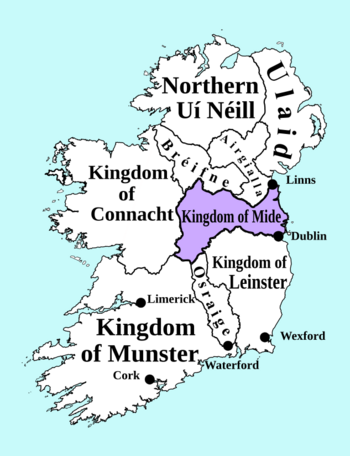Kingdom of Meath facts for kids
Quick facts for kids
Kingdom of Meath
|
|||||||
|---|---|---|---|---|---|---|---|

Meath about the year 900
|
|||||||
| Capital | Tara | ||||||
| Religion | Druidism (until 700s) Christianity (700s–1172) | ||||||
|
|||||||
| Today part of | Ireland | ||||||
Meath (/miːð/ meedh; Modern Irish: Mí; Old Irish: Mide IPA: [ˈmʲiðʲe]) was an important kingdom in Ireland that existed from the 1st to the 12th century AD. Its name, Mide, means "middle," which makes sense because it was located right in the center of the island.
At its largest, the Kingdom of Meath covered a big area. This included all of what is now County Meath (which got its name from the kingdom) and County Westmeath. It also included parts of other counties like Cavan, Dublin, Kildare, Longford, Louth, and Offaly.
Contents
History of the Kingdom of Meath
Early Beginnings and Expansion
The name Mide first referred to the area around the Hill of Uisneach in County Westmeath. This was a special place where the ancient festival of Beltaine was celebrated.
People traditionally say that the larger area of Meath, stretching between the Irish Sea and the River Shannon, was created in the first century. A legendary king named Túathal Techtmar is said to have formed it by taking parts from the other four provinces of Ireland.
Rise of the Uí Néill Dynasty
In the 4th and 5th centuries, a powerful group called the Uí Néill took control of Meath. They came from Connacht and pushed out the local tribes known as the Laigin. The Uí Néill then took on important titles, becoming the Kings of Uisnech in Meath and the Kings of Tara in another area called Brega. They also demanded a special tribute, or payment, from the Laigin people.
One important event was the Battle of Druim Derg in 514. After this battle, the Uí Failge tribe was finally forced out of the plain of Mide. Another group, the Uí Enechglaiss, once controlled parts of Meath, but they were pushed across the Wicklow Mountains in the early 6th century.
Meath's Influence and High Kings
During the Middle Ages in Ireland, the Kings of Meath belonged to a branch of the Uí Néill family called the Clann Cholmáin. These kings became very powerful, even over their own relatives in the southern Uí Néill. They also had influence over other tribes and even the Kingdom of Dublin.
Many Kings of Meath also became High Kings of Ireland. This top position often switched between the Kings of Meath (who were part of the Southern Uí Néill) and the Kings of the Northern Uí Néill for many centuries.
Challenges and Decline
In the 11th and 12th centuries, the Kingdom of Meath faced many challenges. Other powerful kings from different provinces wanted to become High King of Ireland, which put pressure on Meath. The Kingdom of Breifne, led by Tigernán Ua Ruairc, also caused problems.
Because of these conflicts, Meath was often invaded and divided. This caused the kingdom to become weaker and eventually start to fall apart.
End of the Kingdom
After the Norman invasion of Ireland, a major change happened in 1172. Henry II of England, who was then the Lord of Ireland, gave the kingdom of Meath to a Norman knight named Hugh de Lacy. This new territory was called the Lordship of Meath.
The old ruling family of Meath, the Ua Mael Sechlainn (also known as O Melaghlins), were forced to move west. They settled near the River Shannon. Even though they lost their power long before, people with the name O Melaghlin (or McLoughlin, a more common modern version) were still recognized among the Irish nobility as late as the 1690s.
Meath as a Province and Diocese
Meath was also considered one of the five original provinces of Ireland. These were called cúige in Irish, meaning "fifths." The other four provinces are Connacht, Leinster, Munster, and Ulster.
The Diocese of Meath, which is a church area, was set up in 1111 by the Synod of Ráth Breasail. Its borders were very similar to those of the old Kingdom of Meath.
See also
- List of kings of Meath
- Diocese of Meath
Present territories:


